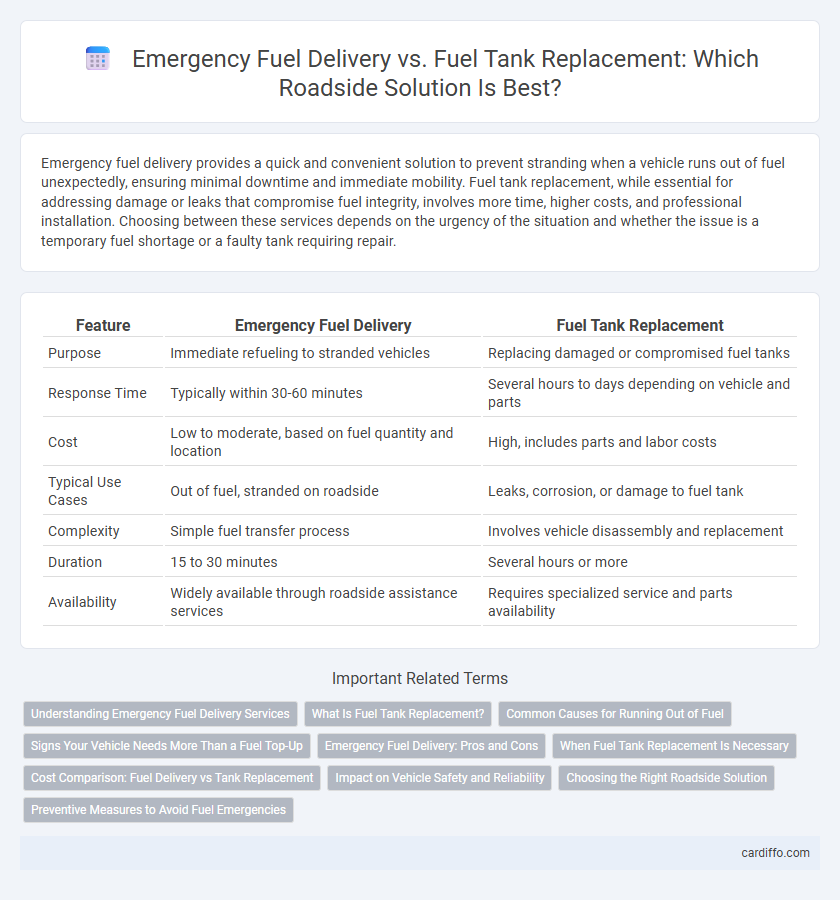Emergency fuel delivery provides a quick and convenient solution to prevent stranding when a vehicle runs out of fuel unexpectedly, ensuring minimal downtime and immediate mobility. Fuel tank replacement, while essential for addressing damage or leaks that compromise fuel integrity, involves more time, higher costs, and professional installation. Choosing between these services depends on the urgency of the situation and whether the issue is a temporary fuel shortage or a faulty tank requiring repair.
Table of Comparison
| Feature | Emergency Fuel Delivery | Fuel Tank Replacement |
|---|---|---|
| Purpose | Immediate refueling to stranded vehicles | Replacing damaged or compromised fuel tanks |
| Response Time | Typically within 30-60 minutes | Several hours to days depending on vehicle and parts |
| Cost | Low to moderate, based on fuel quantity and location | High, includes parts and labor costs |
| Typical Use Cases | Out of fuel, stranded on roadside | Leaks, corrosion, or damage to fuel tank |
| Complexity | Simple fuel transfer process | Involves vehicle disassembly and replacement |
| Duration | 15 to 30 minutes | Several hours or more |
| Availability | Widely available through roadside assistance services | Requires specialized service and parts availability |
Understanding Emergency Fuel Delivery Services
Emergency fuel delivery services provide immediate refueling to vehicles stranded due to an empty fuel tank, ensuring quick and convenient roadside assistance without the need for comprehensive repairs. This service is cost-effective and time-saving compared to fuel tank replacement, which involves diagnosing and fixing leaks or damage that cannot be resolved by simply delivering fuel. Understanding the availability, response time, and coverage area of emergency fuel delivery can prevent prolonged downtime and enhance vehicle reliability during roadside emergencies.
What Is Fuel Tank Replacement?
Fuel tank replacement involves removing the damaged or corroded fuel tank of a vehicle and installing a new one to ensure proper fuel storage and prevent leaks. This process is essential when the existing tank is compromised beyond repair, posing risks like fuel contamination or fire hazards. Unlike emergency fuel delivery, which provides immediate fuel supply to stranded vehicles, fuel tank replacement addresses long-term vehicle safety and functionality.
Common Causes for Running Out of Fuel
Running out of fuel is often caused by miscalculations in fuel consumption, unexpected detours, or malfunctioning fuel gauges leading to inaccurate readings. Emergency fuel delivery provides a quick solution by refueling the vehicle on-site, minimizing downtime and preventing further damage. Fuel tank replacement becomes necessary when leaks or contamination from an empty tank compromise the vehicle's fuel system integrity.
Signs Your Vehicle Needs More Than a Fuel Top-Up
If your vehicle experiences frequent stalling, engine sputtering, or an erratic fuel gauge despite receiving emergency fuel delivery, these are strong indicators that a fuel tank replacement may be necessary. Leaks, corrosion, and persistent fuel odors around the tank area suggest structural damage beyond simple fuel deprivation. Addressing these signs promptly with a professional inspection can prevent further engine damage and ensure roadside safety.
Emergency Fuel Delivery: Pros and Cons
Emergency fuel delivery offers immediate relief by providing fuel on-site, minimizing vehicle downtime and eliminating the need for towing. It is cost-effective compared to fuel tank replacement, which involves expensive parts and labor and potential vehicle modifications. However, emergency fuel delivery is limited to short distances and cannot resolve underlying fuel system issues that a full fuel tank replacement addresses.
When Fuel Tank Replacement Is Necessary
Emergency fuel delivery provides a quick solution for motorists who run out of fuel, restoring temporary mobility without extensive repairs. Fuel tank replacement becomes necessary when the tank suffers from severe damage such as cracks, corrosion, leaks, or structural failure that cannot be effectively repaired. Replacing the fuel tank ensures long-term safety and prevents hazardous fuel leaks, which emergency fuel delivery alone cannot address.
Cost Comparison: Fuel Delivery vs Tank Replacement
Emergency fuel delivery typically costs between $50 and $150, providing a quick and affordable solution compared to fuel tank replacement, which can range from $500 to over $2,000 depending on the vehicle make and model. Fuel delivery minimizes downtime and expenses by refilling the existing tank, whereas tank replacement involves higher labor and parts costs, especially if the damage includes corrosion or leaks. Choosing emergency fuel delivery is generally more cost-effective for running out of fuel situations, while tank replacement is necessary for structural fuel system failures.
Impact on Vehicle Safety and Reliability
Emergency fuel delivery provides a quick solution to prevent vehicle immobilization, reducing the risk of being stranded in unsafe locations and maintaining immediate operational safety. Fuel tank replacement addresses long-term safety concerns by eliminating risks associated with tank corrosion, leaks, and contamination, thereby enhancing overall vehicle reliability. Prioritizing timely emergency fuel delivery ensures short-term safety, while investing in fuel tank replacement supports sustained vehicle performance and reduced breakdown risks.
Choosing the Right Roadside Solution
Emergency fuel delivery provides immediate refueling at the breakdown location, minimizing wait times and getting drivers back on the road quickly. Fuel tank replacement is a more extensive repair option necessary when the tank is damaged or leaking, requiring professional assessment and often vehicle immobilization. Selecting the right roadside solution depends on the specific issue, vehicle condition, and urgency of getting back in transit.
Preventive Measures to Avoid Fuel Emergencies
Emergency fuel delivery provides immediate relief during unexpected fuel shortages, while fuel tank replacement offers a long-term solution by preventing leaks and contamination. Regular maintenance, including timely inspections and cleaning of fuel tanks, significantly reduces the risk of breakdowns and emergency situations. Implementing preventive measures such as proper fuel storage and monitoring fuel quality helps avoid costly roadside emergencies and ensures vehicle reliability.
Emergency Fuel Delivery vs Fuel Tank Replacement Infographic

 cardiffo.com
cardiffo.com